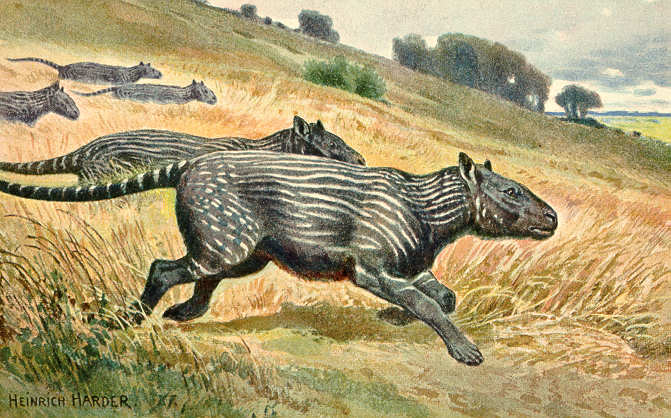- Phenacodus
fossil_range = LatePaleocene to MiddleEocene
regnum =Animal ia
phylum =Chordata
classis =Mammal ia
ordo =Condylarthra
familia =Phenacodontidae
genus = "Phenacodus"
subdivision_ranks = Speciescite journal | author = Thewissen, J.G.M. | year = 1990 | title = Evolution of Paleocene and Eocene Phenacodontidae | journal = University of Michigan Papers on Paleontology | volume = 29 | issue = | pages = 1–107]
subdivision =
* "P. bisonensis"
* "P. condali"
* "P. grangeri"
* "P. intermedius"
* "P. lemoinei"
* "P. magnus"
* "P. matthewi"
* "P. primaevus" (type species )
* "P. teilhardi"
* "P. trilobatus"
* "P. vortmani""Phenacodus" is an
extinct genus of mammals from the latePaleocene through middleEocene , about 55 million years ago. It is one of the earliest and most primitive of theungulate mammals, typifying the familyPhenacodontidae and the orderCondylarthra .Description
The typical "Phenacodus primaevus" was a relatively small ungulate, of slight build, with straight limbs each terminating in five complete toes, and walking in the
digitigrade fashion of the moderntapir . The middle toe was the largest, and the weight of the body was mainly supported on this and the two adjoining digits, which appear to have been encased in hoofs, foreshadowing thetridactyl type common inperissodactyl s and certain extinct groups of ungulates. The skull was small, with proportionately minute brain; and the arched back, stronglumbar vertebrae , long and powerful tail, and comparatively feeble fore-quarters all proclaim kinship with the primitive creodontCarnivora , from which "Phenacodus" and its allies, and through them the more typicalUngulata , are probably derived. All the bones of the limbs are separate, and those of the carpus and tarsus do not alternate - each one in the upper row is placed immediately above the corresponding one in the row below. The full series of forty-four teeth was developed; and the upper molars were short-crowned, orbrachyodont , with six low cusps, two internal, two intermediate and two external, so that they were of the typical primitivebunodont structure. In habits, the animal was cursorial and herbivorous, or possibly carnivorous. In the early Paleocene of North America, the place of the above species was taken by "Tetraclaenodon puercensis", an animal only half the size of "Phenacodus primaevus", with the terminal joints of the limbs intermediate between hoofs and claws, and the first and fifth toes taking their full share in the support of the weight of the body. These two genera may be regarded as forming the earliest stages in the evolution of the horse, coming below "Hyracotherium " (seeEquidae ). As ancestors of theartiodactyl section of the Ungulata, we may look to forms more or less closely related to the North American Lower Eocene genus "Mioclaenus ", typifying the familyMioclaenidae . The species of "Mioclaenus" were five-toed, bunodontCondylarthra , with a decided approximation to the perissodactyl type in the structure of the feet. A second type of Condylarthra from the North American Lower Eocene is represented by the familyMeniscotheriidae , including the genus "Meniscotherium ".These, it is suggested, may have been related to the ancestral
Hyracoidea . Teeth and jaws probably referable to the Condylarthra have been obtained in European early Tertiary formations. All Ungulata probably originated from Condylarthra.References
*1911
Wikimedia Foundation. 2010.

